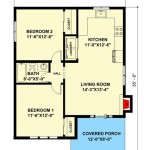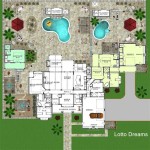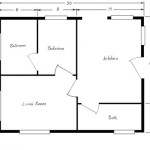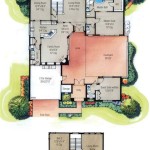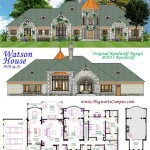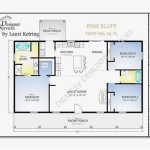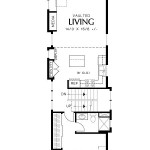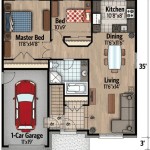House Plans with Mother-in-Law Quarters: A Comprehensive Guide
The demand for house plans incorporating dedicated living spaces for family members, often referred to as "mother-in-law quarters," "accessory dwelling units (ADUs)," or "in-law suites," has seen significant growth. This trend reflects evolving demographics, economic considerations, and a desire for multi-generational living arrangements. These types of house plans offer a blend of independence and proximity, enabling families to support each other while maintaining personal privacy and autonomy.
Designing a house with a mother-in-law quarter involves careful consideration of various factors, including local zoning regulations, accessibility requirements, privacy considerations, and the specific needs of the intended occupant. The resulting design should seamlessly integrate the additional living space into the overall house plan while ensuring functionality and comfort for all residents. This article examines the key aspects involved in planning and selecting house plans featuring mother-in-law quarters.
Understanding the Needs and Requirements
Before embarking on the search for suitable house plans, a thorough assessment of the occupant's needs and requirements is crucial. This involves considering their physical abilities, lifestyle preferences, and long-term care considerations. For instance, if the intended occupant has mobility issues, the mother-in-law quarter should be designed with accessibility in mind, incorporating features such as wider doorways, grab bars in bathrooms, and a zero-step entry. It is important to engage in open communication with the intended occupant to understand their specific needs and preferences.
Lifestyle preferences also play a significant role in the design process. Does the occupant enjoy cooking and entertaining? If so, a fully equipped kitchen might be necessary. Do they require a dedicated workspace for hobbies or remote work? These factors should be considered when determining the size and layout of the mother-in-law quarter. Long-term care considerations are also important, especially if the occupant anticipates needing assistance with daily tasks in the future. Designing for potential future needs can help ensure that the living space remains functional and comfortable as the occupant ages.
Beyond the occupant's personal needs, it's essential to consider the overall harmony of the household. Clear expectations regarding shared spaces, responsibilities, and boundaries should be established to minimize potential conflicts and ensure a positive living environment for all residents. Regular family meetings can help address any concerns and maintain open communication.
Zoning Regulations and Legal Considerations
Zoning regulations and local building codes present crucial constraints on the design and construction of mother-in-law quarters. These regulations vary significantly depending on the location and may dictate the size, location, and permitted uses of the accessory dwelling unit. Failure to comply with these regulations can result in fines, legal action, or even the requirement to remove the unauthorized living space.
It is important to consult with local zoning authorities and building officials to understand the specific requirements in your area. Some jurisdictions may have restrictions on the size of the ADU relative to the main house, while others may require separate entrances and parking spaces. Some areas may also have restrictions on renting out the ADU to non-family members, even if it meets all other requirements. Understanding these regulations is crucial to ensure that your house plan is compliant and that you obtain the necessary permits before starting construction.
Furthermore, consider any homeowner association (HOA) rules that may apply to your property. HOAs may have their own restrictions on the construction of accessory dwelling units, even if they are permitted by local zoning regulations. Reviewing the HOA's governing documents and obtaining approval from the HOA board may be necessary before proceeding with your project. Neglecting to address these legal considerations can lead to costly delays and complications.
Key Design Elements of Mother-in-Law Quarters
The design of a mother-in-law quarter hinges on creating a self-contained living space that promotes independence and comfort. This typically involves incorporating several key elements, including a private entrance, a fully equipped kitchen, a bathroom, a sleeping area, and a living area. The size and layout of these elements should be tailored to the occupant's needs and preferences, as well as the overall size and configuration of the house.
A private entrance is essential for maintaining privacy and independence. This can be a separate exterior door or a dedicated entrance from within the main house that provides a clear separation between the living spaces. A fully equipped kitchen allows the occupant to prepare their own meals and maintain their dietary independence. The kitchen should include essential appliances such as a refrigerator, stove, oven, and microwave, as well as adequate counter space and storage for food and kitchenware.
A private bathroom is another essential element of a mother-in-law quarter. The bathroom should be designed with accessibility in mind, especially if the occupant has mobility issues. Features such as grab bars, a walk-in shower, and a raised toilet seat can make the bathroom safer and more comfortable to use. The sleeping area should be spacious enough to accommodate a bed, dresser, and other bedroom furniture. Natural light and ventilation are important considerations for the sleeping area, as they can contribute to a more comfortable and healthy living environment.
The living area should provide a comfortable space for relaxing, entertaining, and pursuing hobbies. The size and layout of the living area should be tailored to the occupant's lifestyle and preferences. For example, if the occupant enjoys reading, a comfortable armchair and bookcase might be included. If they enjoy watching television, a television and entertainment center might be appropriate. Sufficient power outlets and lighting are also important considerations for the living area.
Privacy and Sound Insulation Considerations
Privacy is paramount in multi-generational living arrangements, and careful attention should be paid to sound insulation and physical separation between the main house and the mother-in-law quarter. Effective sound insulation can minimize noise transfer between the living spaces, ensuring that all residents can enjoy peace and quiet. This can be achieved through various methods, including using soundproof insulation in walls and ceilings, installing solid-core doors, and using double-paned windows.
Physical separation can be achieved through careful placement of the mother-in-law quarter within the house plan. Ideally, the ADU should be located on a separate floor or at the opposite end of the house from the main living areas. This can help minimize noise transfer and create a greater sense of privacy for all residents. If the ADU is located on the same floor as the main living areas, consider adding a buffer zone, such as a hallway or storage area, between the two spaces.
Exterior landscaping can also be used to enhance privacy. Planting trees and shrubs can create a visual barrier between the main house and the mother-in-law quarter, providing a greater sense of seclusion. Fencing can also be used to create a physical barrier and define the boundaries between the living spaces. Consider the placement of windows and doors when designing the landscaping, as this can affect the amount of natural light and privacy in each living space.
Accessibility Features and Universal Design
Incorporating accessibility features and universal design principles into the design of the mother-in-law quarter is crucial for ensuring that the living space remains functional and comfortable for occupants of all ages and abilities. Universal design is a design philosophy that aims to create products and environments that are usable by all people, to the greatest extent possible, without the need for adaptation or specialized design. This includes features such as wider doorways, roll-in showers, lever-handled door hardware, and adjustable-height countertops.
Wider doorways allow for easy passage of wheelchairs and walkers. Roll-in showers eliminate the need to step over a threshold, making them safer and more accessible for people with mobility issues. Lever-handled door hardware is easier to grip and operate than traditional doorknobs, making it more accessible for people with arthritis or other hand impairments. Adjustable-height countertops allow users to customize the height of the work surface to their individual needs.
Other accessibility features to consider include grab bars in bathrooms, non-slip flooring, and adequate lighting. Grab bars provide support and stability for people with mobility issues, reducing the risk of falls. Non-slip flooring can help prevent slips and falls, especially in wet areas such as bathrooms and kitchens. Adequate lighting can improve visibility and reduce the risk of accidents. Incorporating these accessibility features can help ensure that the mother-in-law quarter remains functional and comfortable for years to come.
Integrating the Mother-in-Law Quarters into the Overall House Design
The successful integration of a mother-in-law quarter into the overall house design requires careful planning and attention to detail. The ADU should blend seamlessly with the existing architecture of the house, both aesthetically and functionally. This can be achieved by using similar building materials, colors, and design elements throughout the house. The ADU should also be designed to complement the existing layout of the house, ensuring that it does not disrupt the flow of traffic or create awkward spaces.
Consider the placement of the ADU relative to the main house. Is it located on a separate floor, at the opposite end of the house, or attached to the main house through a shared wall? Each of these options has its own advantages and disadvantages in terms of privacy, sound insulation, and accessibility. Choose the option that best meets the needs of your family and the overall design of the house. Pay attention to the exterior appearance of the ADU. Does it look like an integral part of the house, or does it appear to be an afterthought? Strive to create a cohesive and visually appealing design that enhances the overall curb appeal of the house.
Consider also the potential for future modifications. As the needs of your family change over time, you may want to modify the ADU to accommodate different uses. For example, you may want to convert it into a home office, a guest suite, or a rental unit. Designing the ADU with flexibility in mind can make it easier to adapt to future needs. This might involve using modular construction techniques, incorporating flexible floor plans, or adding extra plumbing and electrical connections.

In Law Suite Plans Give Mom Space And Keep Yours The House Designers

Homes With Mother In Law Suites

6 Bedroom Country Style Home With In Law Suite The Plan Collection

Portfolio Legacy Mother In Law Suite Opal Design Group

House Plans With In Law Suite Floor Designs

Mother In Law Suite Floor Plans Resources

House Plan 76572 Ranch Style With 1948 Sq Ft 2 Bed Bath 1

Adding An In Law Suite To Your Home Designing Perfect House

5 Bedroom Ranch House Plan With In Law Suite 2875 Sq Ft

Inlaw Suite House Plans With Detached Mother In Law Fresh New On Main Floor

